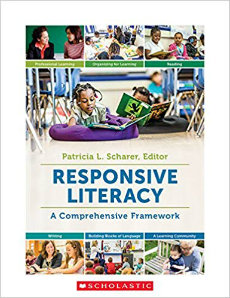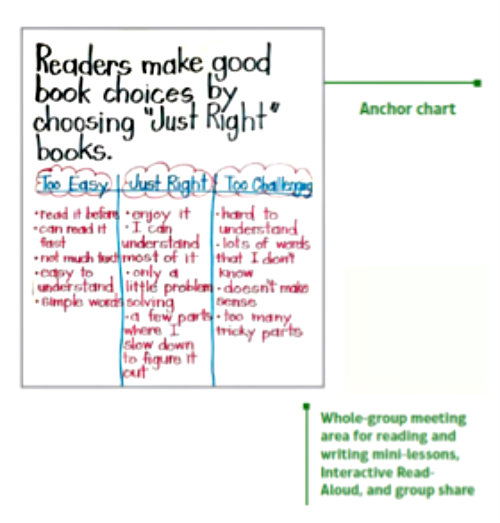A Comprehensive Look at Responsive Literacy
Responsive Literacy: A Comprehensive Framework
Edited by Patricia L. Scharer
(Scholastic, 2018 – Learn more)

I don’t think I have ever read such an extensive and comprehensive book that demonstrates what literacy in elementary classrooms should look like. If you are involved with grades 4-6 literacy in any way, you need to read Responsive Literacy: A Comprehensive Framework. Editor Patricia L. Scharer has done a superb job of compiling research-based and practical information that can be used in any classroom.
If you have a question about Readers Workshop mini lessons…it’s in the book. If you have a question about students responding to books they are reading….It’s in the book. If you have a question about handwriting…it’s in the book. If you have a question about interactive writing…it’s in the book.

Find what you need easily
This book is very easy to follow and apply in your classroom with a minimum of cost and time. There are six color-coded sections so you can easily find the information you are interested in.
Professional Learning: core beliefs that focus on the importance of oral language, “role of children’s’ literature, connection between teachers’ actions and their students’ emotional well being and literate identity.”
Organizing for Learning: the importance of setting up the classroom environment and routines for students to help them become independent readers and writers. There are numerous examples of colorful posters and photos taken from actual classrooms. (Makes you want to go into your classroom and begin reorganizing!)
Reading: introduction to the daily Interactive Read Aloud, how to choose books and prepare to teach fluency, guided reading, shared reading and other aspects of Readers Workshop.
Writing: mini-lessons using the Writers Workshop Model, including interactive writing and assessment. The authors of each chapter provide ample examples of teacher and student conferences (also included as a video resource), samples of student writing, and rubrics.
Building Blocks of Literacy: covers topics such as word study, phonics, handwriting (teaching handwriting so student can “efficiently and legibly make letters and words to facilitate their writing”).
A Learning Community – Students, Teachers, Principals, and Families: a celebration of learning communities and their important function in supporting literacy. This chapter is important because it builds the bridge between school, home, and community and celebrates literacy in action. The authors provide ideas to help teachers on their professional journey, especially those in the role of literacy coaches or professional developers.
A book about discovery
Responsive Literacy: A Comprehensive Framework is quite hefty (400 pages of information, anecdotes, hints, posters, charts, and anecdotes). Each chapter is written by an expert educator in the field: teachers.
Although the book can be used as a text in a college or university, it is not a textbook, a series of lessons plans about Readers and Writers Workshop, or a series of articles about literacy. Essentially it is a book about discovery: discovering what you already know about literacy, learning how to take it a step further, and experiencing those “AHA” moments which bring you joy. It is a book that will cause you to reflect, challenge your thinking, and reaffirm your beliefs.
For example, the chapter “The Role of Emotion in Memory and Comprehension” begins with a quote from Nancy Atwell.
“All that quiet time reading stories chosen for me by an adult who loved me changed me forever and granted me passion for stories and the ability to read fast and with feeling.”
This particular chapter explains the close link between cognition and emotion, especially the role of emotions in an individual’s ability think and remember though self-regulation. I found this chapter to be utterly fascinating. As I learned more about the structure of a student’s working brain (through relevant research and anecdotes the writer provided), I could discern what occurs as our students shift through knowledge to make sense of what they are reading,
Kick starting PD
At the end of each chapter are suggestions for Professional Development. Each suggestion is carefully crafted to help you review the concepts in the chapter and guide you as you collaborate with others to implement the strategies. For example (p. 88):
Have fun probing your own memories and emotions. With a group of friends, think of at least one of the following: A song that immediately comes to mind when you think about high school or college, an object that you treasure even though it has little monetary value or a time you love to remember because you were so happy.
Share your memories connected with them. Now think of something you found very hard to learn. Snare the emotion connected with your struggle.
Now think of one or two struggling students in your class. Plan to observe these students carefully over several days to determine when emotions are working for them in terms of learning and how their emotion might be working against them.
Have a colleague observe you as you work with these students.
A bountiful video library
I always have loved peeking into another teacher’s classroom, whether to check out their charts, bulletin boards, or effective lessons they have taught. However, as the school year progresses, it sometimes becomes more difficult to observe colleagues teaching literacy lessons and engage in a collaborative conversation about how to apply what you observed into your own classroom.
To provide observation opportunities, Scholastic Publishing (in partnership with The Ohio State Literacy Collaborative) has provided an extensive video library of teachers applying many of the lessons. Some of the topics in this library include Student Conferences (expanding story, making narrative connections), Mini-lesson with Expository Text, Interactive Read Aloud, Book Talk, and Share Time.
A book to treasure
This amazing, must-have book is a teacher’s dream. I adore how Responsive Literacy: A Comprehensive Framework is organized. It doesn’t have to be read from cover to cover, but you might become so enchanted with the book that you will want to continue reading it.
If you are thinking of investing in a comprehensive book for your classroom, I would highly recommend this one. If you want to buy a gift for a new teacher or colleague, this is the book to order. I could not recommend this book more highly. It is one of the most comprehensive and user-friendly books around. Five stars! Enjoy!
_________________________
A year into her retirement from teaching fourth graders, Linda Biondi is supervising preservice and student teachers at The College of New Jersey this fall. Over the summer she co-facilitated a weeklong writing institute in conjunction with the National Writing Project at Rider University. She volunteers for two service organizations: Homefront and Dress for Success of Central New Jersey – both have a mission to end poverty and homelessness. The mission of Dress for Success is to empower women to achieve through economic independence


































